Eavor and Turboden have a Joint Development Agreement (JDA) that allows the companies to optimally couple their technology systems for cost-effective energy distribution. This agreement is an integral part of Eavor’s endeavour to scale its technology and to reduce manufacturing costs. The first stage of the JDA created an integrated Eavor-Loop™ and Turboden ORC techno-economic optimization workflow for baseload power.
Last July, Turboden was announced as the supplier for Eavor’s power plant in Geretsried, Bavaria, Germany. This commercial agreement has Turboden building a heat-to-power facility, transforming energy extracted from the Earth into electricity for local energy distribution.
“We have pretty ambitious growth plans, and ORC plants, like what Turboden provides, are enablers of that growth. We need systems like theirs to build our power projects. So, we’re figuring out how to scale these up together, bring the cost down, and manufacture them at a much larger scale,” said Eavor VP of systems engineering and strategy Michael Holmes.
“The partnership has been great. They’re providing the power system for our first commercial project in Germany, and we’re in the process of implementing it right now,”
The Organic Rankine Cycle (ORC) is a closed-loop thermodynamic cycle designed to produce electricity from heat. These systems are capable of harnessing various sources, including biomass, geothermal energy, solar energy, waste heat from industrial processes, waste incinerators, engines, or gas turbines, to generate electric power. Turboden uses this technology in over 400 plants worldwide.
“It’s very much like a steam engine. Eavor-Loops™ produce heat in the 100-200°C range and you can’t make much steam from that, so you don’t get very good efficiency. What ORC does is introduce a lower boiling point working fluid, which is heated and turned into a vapour. Then, it passes that through a turbine which generates electricity, then it is cooled back down to a liquid, and then pumped up to a high pressure again. It’s its own closed-loop cycle,” said Holmes.
Eavor estimates that this 8.2MWe project will power 20,000 homes, which will not only create 600 person-years of drilling services, infrastructure, and powerplant jobs but also effectively eliminate about 44,000 tCO2e GHG emissions annually.



















